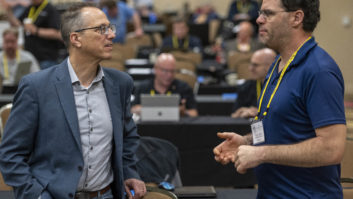It seems almost too quiet. By almost all accounts, the broadcast RF spectrum, specifically for UHF TV, will soon be massively re-allocated.
Will the TV repack will make for one last hurrah for RF engineers otherwise readying themselves for retirement? Sites like 1WTC and 4TS, shown above, may soon see a flurry of activity. Last month, the FCC released preliminary bids to buy back TV spectrum. The reverse auction starts with an offer price and if a station is interested, it applies to participate. The number declines until just the right number of stations go off the air or move to VHF to satisfy the need. By any account, the opening numbers are awesome, with many stations looking at opening bids of around a half-billion dollars.

Broadcasting is a great business, but TV (more so than radio) is less about passion and more about business. Certainly most will at least apply to participate in the auction.
During the DTV transition there was great gnashing of teeth over the limited engineering services, tower crews, manufacturing capacity and the like required to complete the transition on time. In the end, much like World War II, the manufacturing and support world ramped up. It�s also true that some work dragged on, but not so much that anyone really remembers. One benefit of capitalism: When someone is willing to pay the price, the people and material appear.
The same cautionary note has been raised this time regarding the repack. There are fewer transmitter makers, consulting engineers in TV, tower crews and all than there were at the end of the DTV transition six years ago. Unlike radio, where transmitters are replaced every 15 years or so (when the aux is 30 years old), only the earliest DTV transmitters have reached that 15-year end-of-life locus. Domestically, radio transmitter replacement has been the transmitter business for the last six years.
HELP WANTED
What about the people who actually install, test and commission these new transmitters? Broadcast RF engineers often run the gamut: AM-DAs to UHF translators and Class A FMs. Current broadcast RF engineers are often circling the age of retirement and almost to a man bemoan the �fact� that there is no one in the wings to do what they do� assuming, that is, if RF is even needed in the next decade.
Broadcast RF engineers never fully retire. They all have some transmitters they are taking care of, often at some otherwise forsaken transmitter site, for little reward beyond that of being valued and the joy of playing with shiny things.
A real RF guy/gal loves the massive steel (sometimes sitting on a chunk of glass), high power and the magic of blasting a signal sometimes unimaginable distances.
I�m often told that if I want to continue along the broadcast career path, I will need to move over to streaming and IP distribution. I would rather become a dog trainer. (Seriously, there is no understanding people�s passions or love.) When the world doesn�t need RF engineers, I�ll train dogs and play ham radio. Not devoid of IP, but IP as a component, not a world unto itself.
Other than stacking the same box over and over and plugging it in in the same way over and over, IP distribution �engineering� is being awake late at night huddled over a computer screen (maybe at home) trying to get someone on another continent to help work around the faults in their discount code. Yes, computers are an amazing thing, and there are lots of folks who just love to maneuver the same one-foot-square set of typewriter keys all day long. They even get a delight out of a successful configuration. Not an RF engineer.
For a broadcast RF engineer, the repack is maybe the RF Engineering Employment Act of 2015. There is a certain serendipity in this. Those grayhairs out there may have magically timed their careers to be there to do the last big RF project � after which they can teach kids habituated to sitting in front of a screen to take loving care of what they built.












